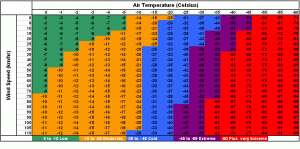5.3 Interpolating on Tables with Negative Numbers
Applications
Sometimes we work with tables where values are negative, or where in at least a part of the table, cell values decrease. One example is wind chill tables.

We’ll use the same approaches to interpolation when working in tables where values are negative, but we need to pay extra attention to the signs. These examples should help!
Examples: Interpolating with Negative Numbers
A) Use this table for wind chill to complete the following interpolations.
- Find the wind chill when the temperature is 15ºF and the wind is 30 mph.
- Find the wind chill when the temperature is 15ºF and the wind is 32 mph.
- Find the wind chill when the temperature is 17ºF and the wind is 30 mph.
- Find the wind chill when the temperature is -20ºF and the wind is 14 mph.
B) Use the humidity table to complete these interpolations.
- Find the relative humidity when the wet bulb is -6ºC and the dry bulb is 6ºC.
- Find the relative humidity when the wet bulb is -8ºC and the dry bulb is -7ºC.
- Find the relative humidity when the wet bulb is 3.5ºC and the dry bulb is 4ºC.
- Find the relative humidity when the wet bulb is 3.5ºC and the dry bulb is 6.5ºC.
Problem Set 5.3
- Relative Humidity 90 Air Temp 80
- Relative Humidity 90 Air Temp 72
- Relative Humidity 95 Air Temp 97
- Temperature 25 F Wind 30 mph
- Temperature 10 F Wind 30 mph
- Temperature -15 F Wind 40 mph

